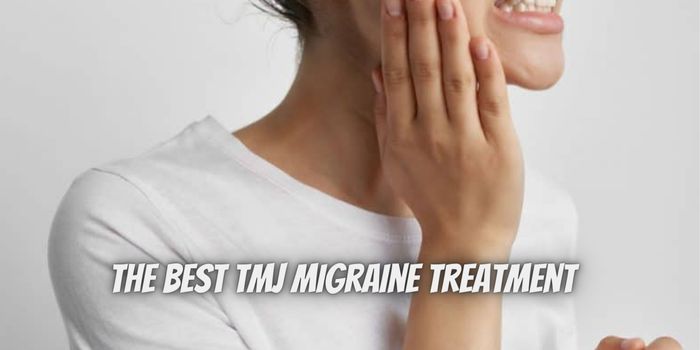Temporomandibular joint (TMJ) disorder, also known as TMJD or TMD, is an ailment that affects the attachments of the lower jaw to the skull and the muscles responsible for its movement. Its occurrence indicates a problem with either one or both of the previously mentioned areas, leading to pain and discomfort in the face, neck, head, and jaw.
Commonly observed symptoms of TMJ disorder are mild or intense jaw pain or tenderness, popping or clicking sounds when opening and closing the mouth, difficulty chewing or biting, and even temporary locking of the jaw from time to time. On top of this, other effects such as headaches, earaches, neck aches, and toothaches can sometimes be present. TMJ migraine from Allure Dental offers effective treatment options for TMJ and migraine, allowing patients to find relief without disrupting the natural flow of their daily routines.
Causes of TMJ migraine.
- Misaligned teeth or bite
Misaligned teeth and bites can cause severe issues with oral health and comfort. The jaw muscles and temporomandibular joint (TMJ) are vulnerable to strain, soreness, and inflammation when the teeth do not fit together correctly. This can lead to increased pain and hinder a person’s ability to chew, speak, or even yawn. In addition, misaligned teeth may create a higher risk of tooth decay and other dental concerns. Solutions such as braces or aligners should be investigated to rectify these issues.
- Teeth are grinding and clenching.
When it comes to bruxism – the medical term for teeth grinding and clenching – repeated contractions of the jaw muscles cause the teeth to press tightly together. This troublesome behavior can occur consciously or unconsciously, leading to discomfort in the temporomandibular joint (TMJ) area and severe headaches. To mitigate these disruptive symptoms, those who suffer from bruxism should act quickly by consulting a medical professional for proper treatment and care.
- Injury or trauma
The temporomandibular joint (TMJ) is a sensitive region that can be easily injured or traumatized, resulting in many painful and uncomfortable symptoms. Symptoms may range from intense jaw pain and tightness to headaches across the face and ears that become increasingly painful with prolonged exposure. Moreover, simple daily activities such as talking, chewing, and yawning can potentially exacerbate this suffering further. In fact, injury to the TMJ is one of the most common causes of dysfunction in the joint, leading to long-term pain and discomfort if left untreated.
Medical treatments for TMJ migraine.
TMJ migraine can be treated using various methods. Some of these methods include:
- Medication.
Medications such as ibuprofen and acetaminophen have been known to relieve TMJ migraine pain. However, it is essential to communicate with your healthcare provider before taking any over-the-counter medications, as they may produce adverse reactions or interact with other drugs you are consuming. Furthermore, utilize the packaging instructions when taking these meds and take only the recommended dosage; ingesting too much medicine can lead to dangerous side effects. Heed your doctor’s advice and stuck to the directions on the box – this way, sweet relief from those pesky TMJ migraines may come sooner!
- Muscle relaxants.
For those suffering from TMJ migraine pain, doctors may suggest taking muscle relaxants to help reduce the tension and inflammation in the jaw muscles, which are the root cause of their discomfort. These medications allow the individual muscle fibers to become more relaxed, making them less vulnerable to strain. During a migraine attack, these muscles commonly remain highly contracted; however, taking muscle relaxants can considerably lessen the severity of the impact.
- Physical therapy exercise.
Physical therapy exercises can offer much-needed relief for those suffering from TMJ migraine pain. Massaging the jaw muscles or gently stretching them can help alleviate tension and discomfort. Additionally, active exercises to flex the muscles in your face are also practical. This includes clenching your teeth together while pushing your tongue against the roof of your mouth or holding a stretched position for a few moments. Incorporating these exercises into your daily routine has decreased TMJ migraine symptoms. However, it is essential that you consult with an experienced physical therapist before beginning any exercise program to ensure you are performing the correct exercises correctly and safely.
- Hot/cold therapy
Hot/Cold Therapy is a popular method for short-term relief from TMJ migraine pain. This technique involves alternating hot and cold compresses on the face or neck to reduce inflammation and relax facial muscles. The heat increases blood flow, while the cold helps decrease inflammation, resulting in temporary respite from discomfort. It is essential, however, not to apply too much heat or cold as this could worsen the symptoms. Hot/Cold Therapy may help provide immediate relief, but it is not suitable as a long-term solution; if persistent pain remains, consult your doctor.
Regarding TMJ migraines, the proper medication and therapy are necessary for successful management or even eradication. It is essential to consult with a doctor to determine the most effective treatment plan for you to reduce discomfort and prevent recurrences. Crafting an optimal protocol ensures that your TMJ migraine troubles are kept at bay.
